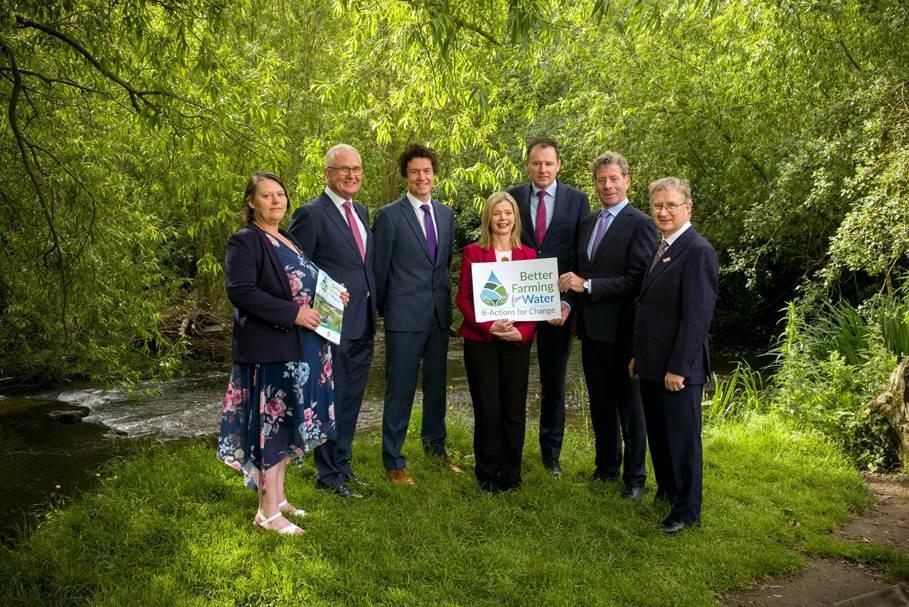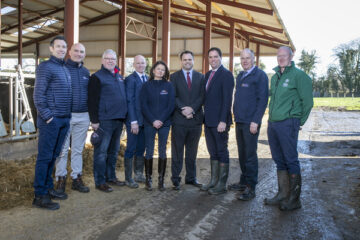The Teagasc ‘Better Farming for Water campaign – 8 Actions for Change’ has been officially launched by Charlie McConalogue TD, Minister for Agriculture, Food and the Marine, at Teagasc Ashtown, Dublin.
Speaking at the launch, Minister McConalogue said, “Water quality is, and ever-more-so will be, a deciding factor in the continued success and future ambition of our agri-food sector. Not one part of the agri industry is immune to the impact that decreasing water quality will have, so no one sector can be immune to taking action. For that reason earlier this year, I asked Teagasc to lead a multi-actor Water Quality Advisory Campaign and I am delighted to see that come to fruition today. This campaign and plan reinforces the vital collaboration necessary between advisors, farmers and the government working towards one ambition; to ensure a sustainable agricultural sector for future generations. This is just one element of the collaborative approach that I am leading on, to improve water quality and maintain Ireland’s nitrates derogation.”
Eight actions for change have been identified that farmers can take on their own farms which will lead to improvements in water quality. These 8-Actions are in 3 critical management areas – Nutrient management, Farmyard management and Land management.
This campaign brings together farmers, advisors, researchers, the agri-food industry, the community and the government in a collective sectoral effort to support farmers to implement solutions to address the quality of the water in their local stream or river. The campaign is being delivered at farm, catchment and regional scale, and is part of a wider all-government approach to improve water quality.
Professor Frank O Mara, Teagasc Director said, “The ‘Better Farming for Water’ campaign is supporting farmers to adopt measures to improve all water bodies, where agriculture is under significant pressure, to Good or High Ecological Status. The buy-in from farmers, industry and the other stakeholders in the agri sector, combined with a determination to succeed, gives me confidence that progress will be made on water quality.”
8-Actions for Change
Teagasc and its partners in the campaign are asking farmers to look at 8-Actions for Change and to select the ones that are most appropriate for their farm and farming enterprise. Those actions aim to:
- Reduce purchased nitrogen (N) and phosphorus (P) surplus per hectare.
- Ensure soil fertility is optimal for lime, phosphorus and potassium.
- Ensure application of fertiliser and organic manure at appropriate times and conditions.
- Have sufficient slurry and soiled water storage capacity.
- Manage and minimise nutrient loss from farmyards and roadways.
- Fence off watercourses to prevent bovine access.
- Promote targeted use of mitigation actions such as riparian margins, buffer strips and sediment traps to mitigate nutrient and sediment loss to water.
- Maintain over-winter green cover to reduce nutrient leaching from tillage soils.
Data-Driven Local Action
One of the key aspects of the campaign is to enhance farmers’ knowledge of local water quality and pollution pressures. Farmers want to know what the quality of the water in the stream, or river that flows through their farm and community. Farmers take pride in protecting the natural environment. This year, Teagasc has produced localised factsheets using EPA maps to facilitate discussions around water quality between advisors and their farmer clients. These have been well received, and cover the actions required on grassland and tillage farms, to tackle both Nitrogen and Phosphorus loads.
Digital Tools for Better On-farm Decisions
A number of digital tools have been developed to support farmers in adopting the actions and making the required changes. AgNav, a new sustainability digital tool jointly developed by Teagasc, ICBF and Bord Bia, with the support of the Department of Agriculture, provides farmers with accurate and verifiable data to support decision making on farms. Further development will ensure that AgNav will have the capacity to calculate Nitrogen and Phosphorus surpluses on individual farms and the impacts of changing management practices.
More farmers have requested nutrient management plans to date in 2024 than in previous years driven by the introduction of the national fertiliser register in September 2023. Through Teagasc NMP online, over 18,000 plans are in progress for farmers by Teagasc and private advisors this year. AgPlanner, a planning tool for preparing a water quality sustainability plan for farmers, has also been developed and is in use by ASSAP and Teagasc advisors.
(Source: Teagasc)



